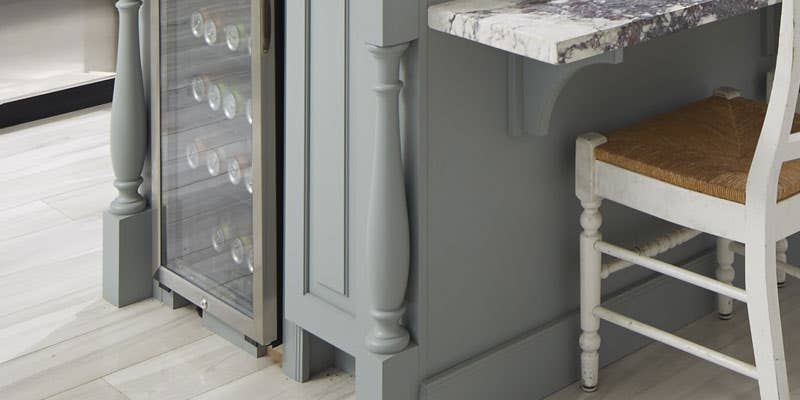Important Variables to Consider When Selecting Legs For Kitchen Area Island
Picking the ideal legs for a cooking area island includes a cautious assessment of numerous variables that can substantially influence both capability and aesthetic allure. Amongst these, the option of material plays a crucial function in making certain longevity, while the layout should enhance the existing style. Additionally, factors to consider such as elevation and weight support are important for security and comfort. As we explore these components, it comes to be clear that each choice can have significant implications for the general cooking area experience. What nuances should be taken into consideration in each of these groups to achieve the optimal equilibrium?
Product Options
When picking legs for a cooking area island, understanding the various material choices is essential for accomplishing both visual charm and structural integrity (Legs For Kitchen Island). The choice of material substantially influences not just the sturdiness of the island but likewise its total style and functionality
Steel legs, usually made from stainless steel or functioned iron, contribute a commercial and modern-day feeling while making certain longevity and stability. These materials are immune to wear and can sustain considerable weight, making them suitable for larger islands.
An additional option is engineered products, like MDF or plywood, which can be more cost-efficient while still providing a variety of surfaces. They may not supply the same level of security as strong wood or metal. Legs For Kitchen Island. Finally, materials such as acrylic or glass can develop a contemporary look, though they may require extra assistance to make certain security.
Eventually, the choice of product for cooking area island legs ought to align with the desired performance and the general motif of the kitchen area.
Design And Style

When considering style, the form and surface of the legs are critical. Tapered legs can give a sense of lightness and beauty, while thicker, much more durable legs can convey strength and stability. In addition, the surface-- be it painted, tarnished, or natural-- should enhance the kitchen cabinetry and counter top materials to produce a unified appearance.
Additionally, the design of the legs can likewise reflect individual taste. Personalized or ornamental legs, such as those including intricate carvings or unique geometric forms, can work as focal factors, adding character and personality to the kitchen area. Inevitably, the right selection will not only improve capability yet also raise the visual appeal, making the kitchen area island a standout function of the home.
Height Considerations
Selecting the ideal elevation for kitchen island legs is important, as it directly impacts both performance and comfort. The common elevation for a kitchen island commonly varies from 36 to 42 inches, aligning with typical counter top elevations. A 36-inch height is suitable for food prep work and food preparation, enabling for comfortable use of cooking area devices and devices. Alternatively, a height of 42 inches is typically preferred for islands meant for bar seats, suiting taller stools and supplying a browse around this web-site laid-back eating experience.

It is additionally necessary to account for customers' preferences and elevations. Tailoring the height can make sure a comfy experience for all member of the family, making the kitchen island a much more functional and delightful room.
Weight Support
Making sure ample weight assistance for cooking area island legs is important for both security and performance. The kitchen area island usually offers numerous objectives, consisting of cooking, eating, and added storage space, demanding a durable assistance framework. When picking legs, it is critical to take into consideration the overall weight capacity called for based on the island's meant use and the products that will certainly be put on it.
The option of product for the legs plays a substantial function in their weight-bearing abilities. Strong wood, metal, and sturdy composites typically offer superior toughness compared to lighter products. Furthermore, the design of the legs-- whether they are right, tapered, or have a pedestal type-- can influence their capability to distribute weight effectively throughout the structure.
In addition, the leg placement need to be tactically planned to improve security. Legs positioned at the corners or with a wider base can much better sustain heavier tons. Constantly seek advice from the producer's specs regarding tons restrictions to make sure that the legs can sustain the desired weight without compromising safety and security. In summary, choosing kitchen island legs with ample weight support is vital for developing a safe and practical cooking area.
Installment and Maintenance
Proper installation and upkeep of kitchen area island legs are crucial for guaranteeing long life and stability. To start, it is crucial to comply with the producer's standards during installation. you can look here This frequently entails protecting the legs to the space station utilizing appropriate fasteners, ensuring that the legs are level and straightened. Utilizing a degree device can assist prevent tottering and boost the overall aesthetic charm of the cooking area island.
When mounted, normal upkeep is necessary to preserve the integrity and look of the legs - Legs For Kitchen Island. For wooden legs, routine cleansing with a moist towel and application of ideal wood gloss can avoid wetness damage and maintain their finish. Steel legs might require a mild cleaning option to eliminate grease and grime, adhered to by a dry cloth to avoid corrosion formation
Additionally, evaluate the legs consistently for indications of wear or damages, such as fractures or loosened joints. Tightening screws or bolts as required can also prolong the life-span of the legs. By adhering to these installment and maintenance methods, homeowners can make sure that their cooking area island remains durable and aesthetically appealing for years to come.
Final Thought

Visual comprehensibility is extremely important in picking the design and style of legs for a kitchen island, as these elements significantly influence the total setting of the area. Tapered legs can provide a feeling of lightness and beauty, while thicker, much more durable legs can share stamina and stability.Picking the ideal elevation for kitchen area island legs is essential, as it straight affects both functionality and convenience. In summary, choosing kitchen island legs with ample weight support is important for developing a functional and secure culinary area.
In verdict, choosing legs for a cooking area island necessitates mindful consideration of numerous elements, consisting of material choices, design, elevation, weight assistance, and installation.
 Kel Mitchell Then & Now!
Kel Mitchell Then & Now! Amanda Bynes Then & Now!
Amanda Bynes Then & Now! Mike Vitar Then & Now!
Mike Vitar Then & Now! Mike Smith Then & Now!
Mike Smith Then & Now! Robin McGraw Then & Now!
Robin McGraw Then & Now!